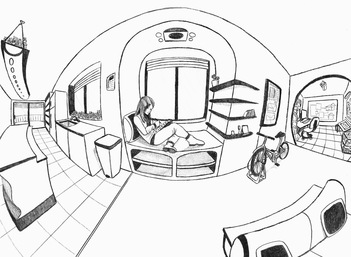11.3 The Home of the Future
Like any passionate technologist, I enjoy imagining futuristic visions of plausible technology scenarios. Yet the pragmatic developer in me knows such visions don’t happen overnight. They require incremental steps in a number of related areas. But at some point, all those incremental services, discoveries, and technologies converge and create inflection points that forever alter the course of history.
I have been fortunate to participate in three major technology revolutions in my lifetime. The first was the introduction and rapid evolution of the personal computer in the 1980s. The second was the supernova expansion of the Internet in the 1990s, and the third was the mobile device revolution in the first decade of the twenty-first century.
Technologies are converging. Cloud computing, palm-sized Internet-connected supercomputers, inexpensive network-aware embedded sensors, autonomous controls, cheap storage, and faster compute cycles will lead us to another amazing era of information processing. With all these technology forces and developments meshing together, here is my prediction of a typical domestic day for a technically savvy homeowner (Figure 51, A Smarter Home, circa 2025).

Figure 51. A Smarter Home, circa 2025
After coming home from a long day at work, Mel’s phone activates the keyless doorway lock that automatically logs the event and video capture to her secure cloud bank. Based on GPS coordinates, Mel’s phone had already called ahead when she was twenty minutes away to tell the HVAC system to turn on the air conditioning. By the time of her arrival, the home was as cool as when she left in the morning.
A parcel is waiting for her on the steps; it’s a box of paper towels that was automatically reordered when the towel dispenser detected it was running low. With the delivery confirmation message, the dispenser’s counter was automatically reset and won’t need to reorder again for a while.
She’s carrying a bag of groceries that her refrigerator suggested that she bring home. The sensors in the fridge detected that the tomatoes had only another day before they would start to turn, so Mel decided to pick up some additional ingredients for making spaghetti sauce.
As she prepares the meal by filling up a pot of water to boil for the spaghetti, the faucet sensors ensure that the purity of the water is contaminant-free. If an anomaly is detected, a message is sent to the city’s water reclamation department automatically reporting the issue.
After dinner, Mel decides to exercise with a ride on her stationary biking simulator. She usually meets a friend on the prairie road course around this time of day, so she dons her motion-tracking 3D headset, queues up her favorite playlist and starts peddling. The headset has a heart rate, blood pressure, and perspiration monitor built into the strap, and these values are translucently overlaid on top of the pastoral scene of rolling hills of swaying wheat. After a few minutes, her friend’s avatar rides close by and pings her, asking if Mel is available for conversation. Mel acknowledges and the two keep each other company as they log half an hour on their bikes. At the end of the ride, each are credited with 200 energy points as a result of their peddling power feeding electricity back into the grid.
With twilight approaching, photosensors lining the window panes prepare the home’s lighting for the evening by drawing the curtains and activating motion detectors in the rooms. Gone are the days of flipping on and off light switches, unintentionally leaving lights on throughout the home even when no one is in the room. There is an override option when guests are visiting, but most of the time the motion detectors do their job well by turning on and off the lights based on presence. This effective lighting strategy has contributed to even more monthly energy credits as a result.
As she begins to settle in for the evening, Mel asks her television to list new videos that her friends have suggested. Voice control has become the norm with content consumption devices and has steadily improved with filtering algorithms and speaker identification. While the videos play back sequentially, overlays of her online status, message queues, weather forecast, and upcoming schedules can be called upon just by asking the television for that information. The weather dictates what her outfit will be the next day. A warm front is moving in, so Mel’s closet rack automatically queues up via RFID sensors embedded in the clothing hangers a section of appropriate outfits to choose from. It’s going to be a bright, sunny day.
I hope you enjoyed that projection of the future. For those who prefer to invent the future instead of waiting around for it to arrive, the technologies to build such a scenario exist today. With the right mix of cost-effective technology, easy implementation, and effective sales, marketing, and timing, someone is going to bring elements of this future scenario to life and forever change the way people interact with their homes. That person could be you!